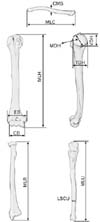1. Dittrick J, Suchey JM. Sex determination of prehistoric central California skeletal remains using discriminant analysis of the femur and humerus. Am J Phys Anthropol. 1986; 70:3–9.
2. Kranioti EF, Bastir M, Sánchez-Meseguer A, Rosas A. A geometric-morphometric study of the Cretan humerus for sex identification. Forensic Sci Int. 2009; 189:111.e1–111.e8.
3. Ross AH, Manneschi MJ. New identification criteria for the Chilean population: Estimation of sex and stature. Forensic Sci Int. 2011; 204:206.e1–206.e3.
4. Singh S, Singh SP. Identification of sex from the humerus. Indian J Med Res. 1972; 60:1061–1066.
5. Holman DJ, Bennett KA. Determination of sex from arm bone measurements. Am J Phys Anthropol. 1991; 84:421–426.
6. Işcan MY, Loth SR, King CA, Shihai D, Yoshino M. Sexual dimorphism in the humerus: a comparative analysis of Chinese, Japanese and Thais. Forensic Sci Int. 1998; 98:17–29.
7. Steyn M, Işcan MY. Osteometric variation in the humerus: sexual dimorphism in South Africans. Forensic Sci Int. 1999; 106:77–85.
8. Vance VL, Steyn M, L'Abbé EN. Nonmetric sex determination from the distal and posterior humerus in black and white South Africans. J Forensic Sci. 2011; 56:710–714.
9. Safont S, Malgosa A, Subirà ME. Sex assessment on the basis of long bone circumference. Am J Phys Anthropol. 2000; 113:317–328.
10. Mall G, Hubig M, Büttner A, Kuznik J, Penning R, Graw M. Sex determination and estimation of stature from the long bones of the arm. Forensic Sci Int. 2001; 117:23–30.
11. Ríos Frutos L. Metric determination of sex from the humerus in a Guatemalan forensic sample. Forensic Sci Int. 2005; 147:153–157.
12. Barrier IL, L'Abbé EN. Sex determination from the radius and ulna in a modern South African sample. Forensic Sci Int. 2008; 179:85.e1–85.e7.
13. Kranioti EF, Nathena D, Michalodimitrakis M. Sex estimation of the Cretan humerus: a digital radiometric study. Int J Legal Med. 2011; 125:659–667.
14. Kranioti EF, Michalodimitrakis M. Sexual dimorphism of the humerus in contemporary Cretans: a population-specific study and a review of the literature. J Forensic Sci. 2009; 54:996–1000.
15. Uzün I, Işcan MY, Celbiş O. Forearm bones and sexual variation in Turkish population. Am J Forensic Med Pathol. 2011; 32:355–358.
16. Charisi D, Eliopoulos C, Vanna V, Koilias CG, Manolis SK. Sexual dimorphism of the arm bones in a modern greek population. J Forensic Sci. 2011; 56:10–18.
17. Milner GR, Boldsen JL. Humeral and femoral head diameters in recent white American skeletons. J Forensic Sci. 2012; 57:35–40.
18. Bašić Ž, Anterić I, Vilović K, Petaros A, Bosnar A, Madžar T, Polašek O, Anđelinović Š. Sex determination in skeletal remains from the medieval Eastern Adriatic coast - discriminant function analysis of humeri. Croat Med J. 2013; 54:272–278.
19. Rogers TL. A visual method of determining the sex of skeletal remains using the distal humerus. J Forensic Sci. 1999; 44:57–60.
20. Tanaka H, Lestrel PE, Uetake T, Kato S, Ohtsuki F. Sex differences in proximal humeral outline shape: elliptical Fourier functions. J Forensic Sci. 2000; 45:292–302.
21. Choi BY, Chung IH. Sex discrimination with the metric measurements of the Korean dried pelvic bones by discriminant function analysis. Korean J Phys Anthropol. 1999; 12:151–158.
22. Choi BY, Lee KS, Han SH, Park DK, Lim NH, Koh KS, Kim HJ, Kang HS. Group analysis using the metric measurements of Korean skulls. Korean J Phys Anthropol. 2001; 14:207–215.
23. Park DK, Lee UY, Lee JH, Choi BY, Koh KS, Kim HJ, Park SJ, Han SH. Non-metric traits of Korean skulls. Korean J Phys Anthropol. 2001; 14:117–126.
24. Ji EK, Rhyu IJ, Cheon YH, Lee EK, Kim YM, Shin DY, Hwang SJ. Gender difference of corpus callosum in Korean neonate. Korean J Phys Anthropol. 2001; 14:333–338.
25. Rhyu IJ, Ryu JY, Park KW, Lee DH, Park KY, Park KH, Hwang SJ. Gender difference on corpus callosum in Korean adults. Korean J Phys Anthropol. 2005; 18:169–177.
26. Kim DI, Lee UY, Park DK, Kim YS, Han KH, Kim KH, Han SH. Morphometrics of the hyoid bone for human sex determination from digital photographs. J Forensic Sci. 2006; 51:979–984.
27. Park DK, Kim DI, Lee UY, Han KH, Kim KH, Han SH. Morphometric analysis of the Korean thyroid cartilage for identification of sex: metric study. Korean J Phys Anthropol. 2003; 16:129–136.
28. Hu KS, Koh KS, Park KK, Kang MK, Chung IH, Kim HJ. Non-metric traits of Korean mandibles. Korean J Phys Anthropol. 2000; 13:161–172.
29. Hu KS, Koh KS, Jung HS, Kang MK, Choi BY, Kim HJ. Physical anthropological characteristics and sex determinative analysis by the metric traits of Korean mandibles. Korean J Phys Anthropol. 2000; 13:369–382.








 PDF
PDF ePub
ePub Citation
Citation Print
Print









 XML Download
XML Download